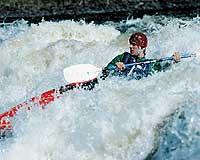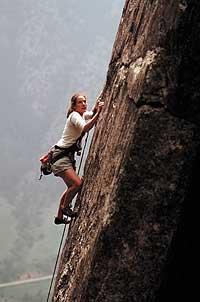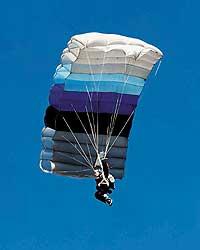Adventure sports playing with risk

Risky sports have a large number of fans among young people in our society, and not so much among young people, especially among those who prefer to flee from everyday customs and live strong emotions. There are many activities that are grouped under this generic name and very different: bridge jump, kayak, free fall, canyoning descent, climbing, hydrospeed, etc.
However, this ‘fashion’ also has its negative side: every year many people die practicing these sports activities. Therefore, security is a key factor to avoid any problems.
In principle, anyone can participate in this type of adventure sports, but, however, they are not recommended for all people: those who have cardiovascular or nervous problems, those who are affected by epilepsy, vertigo or phobia, hypertents, young children or those who do not want to take risks, would prefer not to practice this type of sports.
On the other hand, nowadays there are more and more associations and companies that offer the possibility of carrying out this type of ‘adventures’ with the best guarantees and with the help of prepared monitors.
Accident prevention measures
This type of company, in addition to having trained people with extensive experience in these exercises, and offering all the sports equipment properly approved and in good condition, have insurance policies, since in these sports the most experts can also have accidents. That is why you should never practice this type of sports on your own.
In addition to having a risk assistance team, we must think in advance about what health services we have and how we will move the injured person to the hospital.

In any case, it is advisable that anyone who is fond of adventure sports have knowledge of first aid such as the techniques necessary to treat fractures, bleeding or injuries. In addition, you always have to carry a medicine kit with everything you need to face a mild accident
All these control measures can result in accidents, either due to human failure, deterioration of equipment or bad weather. According to the Spanish Association of Brain Damage, “these sports are the main cause of an increase of more than 30% of cranioencephalic trauma among youth”.
Water sports
Spring and summer are the best times of the year to carry out this type of activities: rafting, hydrospeed, canoeing, diving or canyoning, to mention some of the largest.
Through ravines and canyons it is called descent of canyons when descending by the riverbed. In this sport, which is practiced with wetsuit and rappel material, many surprises can be given, but the practitioner puts all these risks into the game. This sport is practiced mainly in the Pyrenean rivers, especially in the area of Catalonia.
The Pyrenean rivers, as well as some of those that lead to the Cantabrian Sea, are ideal places to practice sports that are practiced in the currents, in their different modalities. For example, you can do rafting (descending on a raft in fast water), hydrospeed (in the form of sledding or sledding) and canoeing (using different types of canoeing), taking advantage of the flow, speed and slope of these rivers.
Diving also has many fans, although our sea is not the most appropriate for it. To dive without bottles is enough a tube, special glasses and fins. But to dive with a bottle of compressed air it is necessary to take a previous course to know and start the minimum safety measures in underwater tours.

Water engines have also achieved great success in recent years. For the driving of these engines that can reach a power of 45 horses, a special license issued by the Federation of Maritime Sports, with a minimum age of 18 years, will be required. However, those over the age of 16 can travel on these engines with the consent of their parents.
Activities on land
The best known are mountaineering, climbing, mountaineering and mountain biking.
Climbing began to be considered as a sports discipline about 30 years ago, consists of walking through the artificial walls (called rocodromo) or the natural walls of the rocks. Safety measures are the same as those used on the mountain, especially dynamic ropes and harnesses. These materials are an essential tool for the safety of the climber and must always be in good condition. This sport is usually performed in groups of two to three, relying and supporting each other, and the climbs are classified according to the difficulty.
Walking on the mountain is a sport as old as man; for the pleasure of walking, and for the curiosity of knowing new places, take a backpack to the back and is walking through the mountain with a suitable shoe, paths and trails. This sport can be practiced by anyone who wants nature or nature, taking into account their physical condition and the difficulty of the chosen route.
During climbing, and also on the mountain, it is advisable to have a minimum knowledge of altitude sickness. Altitude sickness is a disorder or disorder that manifests itself when the body has difficulty adapting and adapting to the low amount of oxygen it receives as a result of height. Without abandoning the one-day deadline, 20% of people (i.e. one in five) who climb from sea level to a height of 2,500 m (or higher, of course) may present symptoms of this pathology. Therefore, it is advisable to know the signs and symptoms to take action as soon as possible.
Human Passion: Flying
Euskal Herria is also not the best place to fly, the weather and the orography do not help too much, but nevertheless, these sports activities have a large number of fans: paragliding, free fall, hang gliding, ultra-fast, balloons, parachuting, with or without flight engine, acrobatics and aeromodelling. However, in all cases minimal atmospheric conditions are required, keeping the material in perfect condition so that all activities are carried out safely.

The delta slope consists of flying a person tied to two wings, like birds or birds, planning over the valleys. This risky sport is widespread among us and there are schools preparing for it.
The so-called "bridge jump" is, however, the most successful of this type of sports. It is to tie a climbing rope to a harness and jump over a bridge, once the other end has tied well to the bridge. Instead of making the jump with a rope, it can also be done with an elastic rubber, which causes more emotion, since the jumper vomits by the elastic rubber.
This type of activities generate a high risk of adrenaline, since they make the one who tries it feel very threatened. However, to avoid surprises, it is very important to check the entire team before each jump.
Buletina
Bidali zure helbide elektronikoa eta jaso asteroko buletina zure sarrera-ontzian










